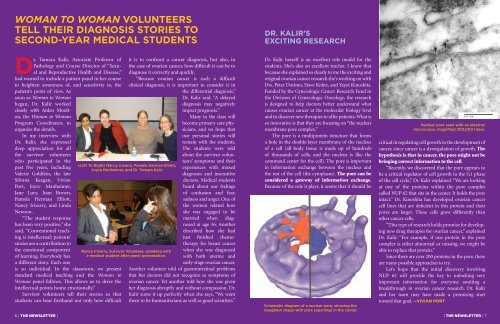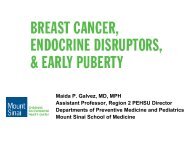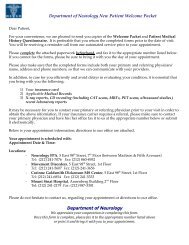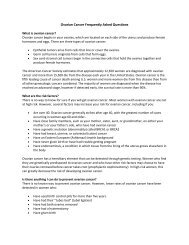WOM N WOM N - Mount Sinai Hospital
WOM N WOM N - Mount Sinai Hospital
WOM N WOM N - Mount Sinai Hospital
You also want an ePaper? Increase the reach of your titles
YUMPU automatically turns print PDFs into web optimized ePapers that Google loves.
<strong>WOM</strong>AN TO <strong>WOM</strong>AN VOLUNTEERS<br />
TELL THEIR DIAGNOSIS STORIES TO<br />
SECOND-YEAR MEDICAL STUDENTS<br />
DR. KALIR’S<br />
EXCITING RESEARCH<br />
Dr. Tamara Kalir, Associate Professor of<br />
Pathology and Course Director of “Sexual<br />
and Reproductive Health and Disease,”<br />
had wanted to include a patient panel in her course<br />
to heighten awareness of, and sensitivity to, the<br />
patient’s point of view. As<br />
soon as Woman to Woman<br />
began, Dr. Kalir worked<br />
closely with Arden Moulton,<br />
the Woman to Woman<br />
Program Coordinator, to<br />
organize the details.<br />
In my interview with<br />
Dr. Kalir, she expressed<br />
deep appreciation for all<br />
the survivor volunteers<br />
who participated in the<br />
past five years, including<br />
Valerie Goldfein, the late<br />
Silvana Keegan, Vivian<br />
Port, Joyce Manheimer,<br />
Jane Lury, Joan Brown,<br />
Pamela Herman Elliott,<br />
Nancy Irizarry, and Linda<br />
Newson.<br />
“The student response<br />
has been very positive,” she<br />
said. “Conventional teaching<br />
is intellectual; patients’<br />
stories are a contribution to<br />
the emotional component<br />
of learning. Everybody has<br />
a different story. Each one<br />
is so individual. In the classroom, we present<br />
standard medical teaching and the Woman to<br />
Woman panel follows. This allows us to drive the<br />
intellectual points home emotionally.”<br />
Survivor volunteers tell their stories so that<br />
students can hear firsthand not only how difficult<br />
6 | THE NEWSLETTER |<br />
(Left To Right) Nancy Irizarry, Pamela Herman Elliott,<br />
Joyce Manheimer, and Dr. Tamara Kalir.<br />
Nancy Irizarry, Survivor Volunteer, speaking with<br />
a medical student after panel presentation.<br />
it is to confront a cancer diagnosis, but also, in<br />
the case of ovarian cancer, how difficult it can be to<br />
diagnose it correctly and quickly.<br />
“Because ovarian cancer is such a difficult<br />
clinical diagnosis, it is important to consider it in<br />
the differential diagnosis,”<br />
Dr. Kalir said. “A delayed<br />
diagnosis may negatively<br />
impact prognosis.”<br />
Many in the class will<br />
become primary care physicians,<br />
and we hope that<br />
our personal stories will<br />
remain with the students.<br />
The students were told<br />
about the survivor volunteers’<br />
symptoms and their<br />
experiences with missed<br />
diagnoses and insensitive<br />
doctors. Medical students<br />
heard about our feelings<br />
of confusion and fear,<br />
sadness and anger. One of<br />
the women related how<br />
she was engaged to be<br />
married when diagnosed<br />
at age 36. Another<br />
described how she had<br />
just finished chemotherapy<br />
for breast cancer<br />
when she was diagnosed<br />
with both uterine and<br />
early-stage ovarian cancer.<br />
Another volunteer told of gastrointestinal problems<br />
that her doctors did not recognize as symptoms of<br />
ovarian cancer. Yet another told how she was given<br />
her diagnosis abruptly and without compassion. Dr.<br />
Kalir sums it up perfectly when she says, “We want<br />
them to be humanitarians as well as good scientists.”<br />
Dr. Kalir herself is an excellent role model for the<br />
students. She’s also an excellent teacher. I know that<br />
because she explained so clearly to me the exciting and<br />
original ovarian cancer research she’s working on with<br />
Drs. Peter Dottino, Stave Kohtz, and Yayoi Kinoshita.<br />
Funded by the Gynecologic Cancer Research Fund in<br />
the Division of Gynecologic Oncology, the research<br />
is designed to help doctors better understand what<br />
causes ovarian cancer at the molecular biology level<br />
and to discover new therapies to offer patients. What is<br />
so innovative is that they are focusing on “the nuclear<br />
membrane pore complex.”<br />
The pore is a multiprotein structure that forms<br />
a hole in the double-layer membrane of the nucleus<br />
of a cell (all body tissue is made up of hundreds<br />
of thousands of cells, and the nucleus is like the<br />
command center for the cell). The pore is important<br />
in information exchange between the nucleus and<br />
the rest of the cell (the cytoplasm). The pore can be<br />
considered a gateway of information exchange.<br />
Because of the role it plays, it seems that it should be<br />
Schematic diagram of a nuclear pore, showing the<br />
doughnut shape with pore (opening) in the center.<br />
Nuclear pore seen with an electron<br />
microscope, magnified 200,000 times.<br />
critical in regulating cell growth in the development of<br />
cancer, since cancer is a dysregulation of growth. The<br />
hypothesis is that in cancer, the pore might not be<br />
bringing correct information to the cell.<br />
“Recently, we discovered that the pore appears to<br />
be a critical regulator of cell growth in the G1 phase<br />
of the cell cycle,” Dr. Kalir explained. “We are looking<br />
at one of the proteins within the pore complex<br />
called NUP 62 that sits in the center. It holds the pore<br />
intact.” Dr. Kinoshita has developed ovarian cancer<br />
cell lines that are deficient in this protein and their<br />
pores are larger. These cells grow differently than<br />
other cancer cells.<br />
“This type of research holds promise for developing<br />
new drug therapies for ovarian cancer,” explained<br />
Dr. Kalir. “For example, if one protein in the pore<br />
complex is either abnormal or missing, we might be<br />
able to replace that protein.”<br />
Since there are over 200 proteins in the pore, there<br />
are many possible approaches to try.<br />
Let’s hope that the initial discovery involving<br />
NUP 62 will provide the key to unlocking very<br />
important information for everyone awaiting a<br />
breakthrough in ovarian cancer research. Dr. Kalir<br />
and her team may have made a promising start<br />
toward that goal. —VIVIAN PORT<br />
| THE NEWSLETTER | 7



![December 2, 2012 [PDF] - Mount Sinai Hospital](https://img.yumpu.com/51092274/1/190x245/december-2-2012-pdf-mount-sinai-hospital.jpg?quality=85)
![January 21, 2013 [PDF] - Mount Sinai Hospital](https://img.yumpu.com/50916550/1/190x245/january-21-2013-pdf-mount-sinai-hospital.jpg?quality=85)

![February 3, 2013 [PDF] - Mount Sinai Hospital](https://img.yumpu.com/50584982/1/190x245/february-3-2013-pdf-mount-sinai-hospital.jpg?quality=85)
![March 18, 2012 [PDF] - Mount Sinai Hospital](https://img.yumpu.com/50462098/1/190x245/march-18-2012-pdf-mount-sinai-hospital.jpg?quality=85)



![Partners Program Guide [PDF] - Mount Sinai Hospital](https://img.yumpu.com/49411954/1/190x245/partners-program-guide-pdf-mount-sinai-hospital.jpg?quality=85)

![March 19 - April 1, 2012 [PDF] - Mount Sinai Hospital](https://img.yumpu.com/48990923/1/190x245/march-19-april-1-2012-pdf-mount-sinai-hospital.jpg?quality=85)
![PGY-1 Residency Application [PDF] - Mount Sinai Hospital](https://img.yumpu.com/48577701/1/190x245/pgy-1-residency-application-pdf-mount-sinai-hospital.jpg?quality=85)


